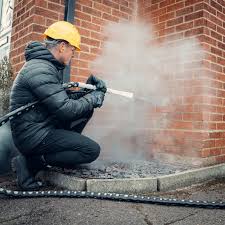
Why Dry Ice Blasting Beats Traditional Cleaning Methods
Sandblasting, pressure washing, and chemical solvents have been used by various industries for efficient surface cleaning. But a brand-new technique called dry ice blasting is catching on fast. Dry ice blasting is renowned for its accuracy, environmental friendliness, and non-abrasive action; it surpasses conventional cleaning techniques in almost every aspect.
This post will explain how dry ice blasting operates, why it’s superior to conventional techniques, and why it’s the most intelligent cleaning option available.
What Is Dry Ice Blasting?
High-velocity dry ice pellets (solid carbon dioxide) are used in the dry ice blasting method of surface cleaning. These pellets rapidly sublimate—turning from solid to gas—when they come into contact with a surface, removing impurities. Dry ice blasting doesn’t require chemicals, water, or abrasive force like other techniques do.
The method is quicker, cleaner, and more ecologically friendly because there is no secondary waste because the dry ice evaporates upon contact.
Dry Ice Blasting vs Traditional Cleaning Methods
Let’s break down the key reasons dry ice blasting beats traditional cleaning methods:
1. Non-Abrasive and Surface Safe
Traditional methods like sandblasting or wire brushing physically scrape away dirt and coatings. While effective, they often damage delicate surfaces. Dry ice blasting, on the other hand, cleans without abrasion.
This means surfaces such as:
-
Historic brickwork
-
Electrical panels
-
Delicate machinery
-
Painted or polished metals
stay intact and unscathed after cleaning.
Whether you’re restoring an antique monument or cleaning industrial equipment, dry ice blasting preserves the material’s original quality.
2. No Water or Chemicals
Pressure washing uses gallons of water. Chemical cleaning can involve harsh, toxic substances. Both methods can introduce hazards to the environment and your workspace.
Dry ice blasting:
-
Uses no water
-
Involves no chemicals
-
Leaves no toxic residues
It’s an eco-friendly solution that meets modern environmental standards and reduces the risk of water damage, chemical burns, or contamination.
3. No Secondary Waste
Traditional blasting methods create a mess — think sand, sludge, or dirty water — that needs costly disposal. Dry ice blasting creates no secondary waste because the dry ice sublimates into gas. Only the dirt, grease, or paint you remove needs to be cleaned up.
This results in:
-
Faster job completion
-
Lower cleanup and disposal costs
-
Safer work environments
4. Efficient and Precise Cleaning
Dry ice blasting can reach tiny crevices and detailed surfaces without dismantling equipment. Traditional cleaning often requires time-consuming disassembly and reassembly.
With dry ice blasting:
-
You clean in-place (in-situ)
-
Downtime is reduced
-
Labor costs are lower
In industries like manufacturing or food production, saving time means saving money.
5. Environmentally Sustainable
More companies are under pressure to adopt green practices. Dry ice blasting aligns with sustainability goals because:
-
The CO₂ used is recycled from other industrial processes.
-
No new emissions are created during cleaning.
-
There’s no use of chemicals that harm ecosystems.
Choosing dry ice blasting shows your commitment to protecting the planet while maintaining high standards of cleanliness.
6. Safe for Equipment and Workers
Dry ice blasting is not poisonous, combustible, or conductive. It is safe to use around wiring, motors, and electrical systems without exposing workers to hazardous chemicals or short-circuiting machinery.
Dry ice blasting provides a safer, more seamless operation than conventional techniques that call for additional PPE or shutdowns.
Where Dry Ice Blasting Excels
Dry ice blasting is particularly beneficial in industries like:
-
Manufacturing: Removing buildup on molds, machinery, and production equipment.
-
Automotive: Cleaning engines, paint booths, and tools without harsh abrasion.
-
Food and Beverage: Sanitary cleaning of processing equipment without water or chemicals.
-
Fire and Smoke Restoration: Removing soot, char, and odor from structures safely.
-
Historic Preservation: Restoring old brick, stone, and wood without damage.
-
Power Generation: Cleaning turbines, electrical panels, and insulation.
Wherever cleanliness and surface protection matter, dry ice blasting delivers outstanding results.
As you can see, dry ice blasting outperforms in almost every important area.
Conclusion
Dry ice blasting is superior to conventional cleaning techniques due to its speed, safety, effectiveness, and environmental friendliness. It facilitates sustainable business operations, lessens cleanup time, and safeguards fragile surfaces.
Dry ice blasting isn’t simply a better way to clean; it’s the way of the future for surface cleaning in a world that is shifting toward safer, more responsible, and smarter solutions.
Dry ice blasting is the answer you’ve been looking for if you’re prepared to experience a new level of cleanliness without the hazards and waste of conventional procedures.